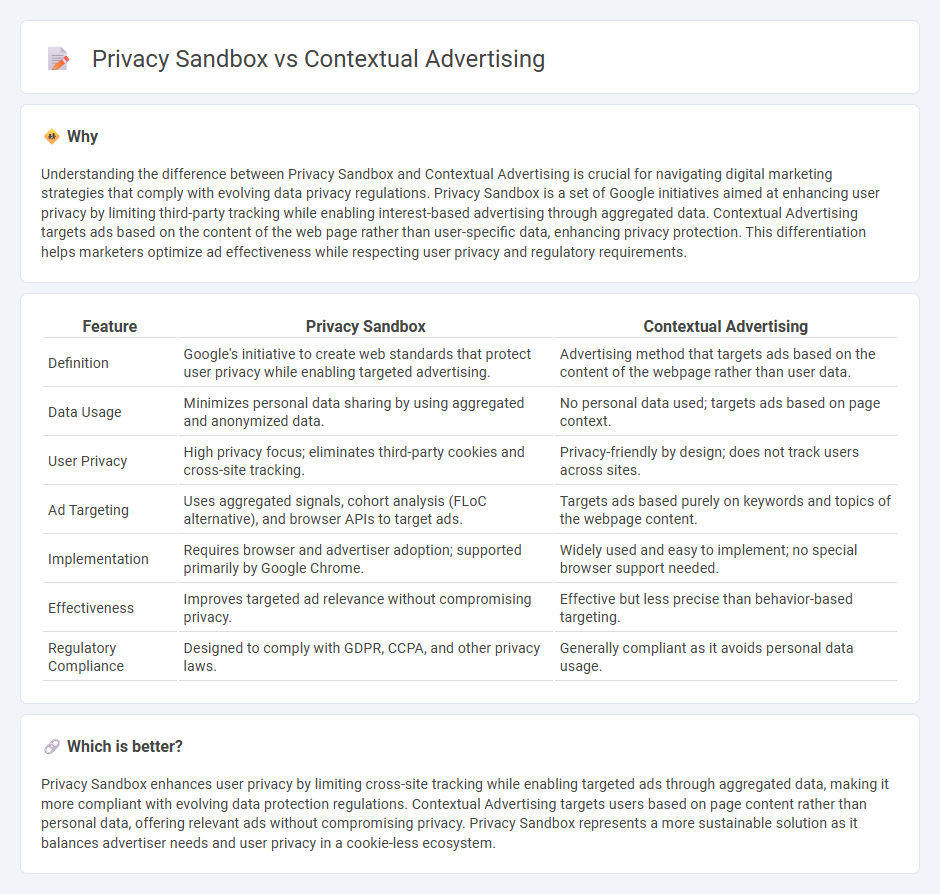
Privacy Sandbox revolutionizes online advertising by enhancing user privacy through anonymized data processing, reducing reliance on third-party cookies, and promoting secure data sharing. Contextual Advertising targets users by analyzing webpage content instead of personal information, ensuring relevant ads while preserving privacy. Discover how these innovations reshape digital marketing strategies and protect user data.
Why it is important
Understanding the difference between Privacy Sandbox and Contextual Advertising is crucial for navigating digital marketing strategies that comply with evolving data privacy regulations. Privacy Sandbox is a set of Google initiatives aimed at enhancing user privacy by limiting third-party tracking while enabling interest-based advertising through aggregated data. Contextual Advertising targets ads based on the content of the web page rather than user-specific data, enhancing privacy protection. This differentiation helps marketers optimize ad effectiveness while respecting user privacy and regulatory requirements.
Comparison Table
| Feature | Privacy Sandbox | Contextual Advertising |
|---|---|---|
| Definition | Google's initiative to create web standards that protect user privacy while enabling targeted advertising. | Advertising method that targets ads based on the content of the webpage rather than user data. |
| Data Usage | Minimizes personal data sharing by using aggregated and anonymized data. | No personal data used; targets ads based on page context. |
| User Privacy | High privacy focus; eliminates third-party cookies and cross-site tracking. | Privacy-friendly by design; does not track users across sites. |
| Ad Targeting | Uses aggregated signals, cohort analysis (FLoC alternative), and browser APIs to target ads. | Targets ads based purely on keywords and topics of the webpage content. |
| Implementation | Requires browser and advertiser adoption; supported primarily by Google Chrome. | Widely used and easy to implement; no special browser support needed. |
| Effectiveness | Improves targeted ad relevance without compromising privacy. | Effective but less precise than behavior-based targeting. |
| Regulatory Compliance | Designed to comply with GDPR, CCPA, and other privacy laws. | Generally compliant as it avoids personal data usage. |
Which is better?
Privacy Sandbox enhances user privacy by limiting cross-site tracking while enabling targeted ads through aggregated data, making it more compliant with evolving data protection regulations. Contextual Advertising targets users based on page content rather than personal data, offering relevant ads without compromising privacy. Privacy Sandbox represents a more sustainable solution as it balances advertiser needs and user privacy in a cookie-less ecosystem.
Connection
Privacy Sandbox is a Google initiative designed to enhance user privacy by limiting cross-site tracking while enabling interest-based advertising through anonymized data. Contextual Advertising aligns with Privacy Sandbox principles by targeting ads based on webpage content rather than personal user information, reducing reliance on third-party cookies. Together, they represent a shift in digital marketing towards privacy-preserving ad technologies that balance user data protection with effective ad delivery.
Key Terms
User Targeting
Contextual advertising targets users based on the content they are viewing, using keywords and site context to deliver relevant ads without collecting personal data, which aligns with growing privacy concerns. The Privacy Sandbox initiative by Google aims to phase out third-party cookies and enable more privacy-preserving user targeting methods through technologies like FLoC and Topics API. Explore how these innovative approaches balance effective advertising with enhanced user privacy and learn more about future trends in user targeting.
Data Privacy
Contextual advertising prioritizes user privacy by targeting ads based on webpage content rather than personal data, reducing the need for intrusive tracking cookies. The Privacy Sandbox initiative by Google aims to foster a safer internet by developing new technologies that enable personalized advertising without compromising individual privacy. Explore how these evolving approaches balance effective marketing strategies with stringent data privacy standards.
Interest-based Ads
Interest-based ads prioritize user preferences by analyzing browsing behavior within Contextual Advertising, enhancing ad relevance without relying heavily on personal data. Privacy Sandbox initiatives seek to balance targeted advertising and user privacy by employing aggregated and anonymized interest signals instead of tracking individual users. Explore how these evolving technologies reshape digital marketing strategies and consumer privacy dynamics.
Source and External Links
What is Contextual Advertising & Why It Matters - TEGNA - Contextual advertising delivers relevant ads to users based on the content they are currently viewing, enhancing targeting and brand safety without relying on cookies.
What is Contextual Advertising? Why is it Important? - Amazon Ads - Contextual advertising places ads closely aligned with the content of a web page or digital environment, increasing engagement by matching ads to viewers' current interests using machine learning and keyword analysis.
What is Contextual Advertising? Why Is It Important? - Publift - Contextual advertising displays ads based on the webpage's content and context, aiming for a seamless and relevant user experience, especially as third-party cookies are phased out.
 dowidth.com
dowidth.com